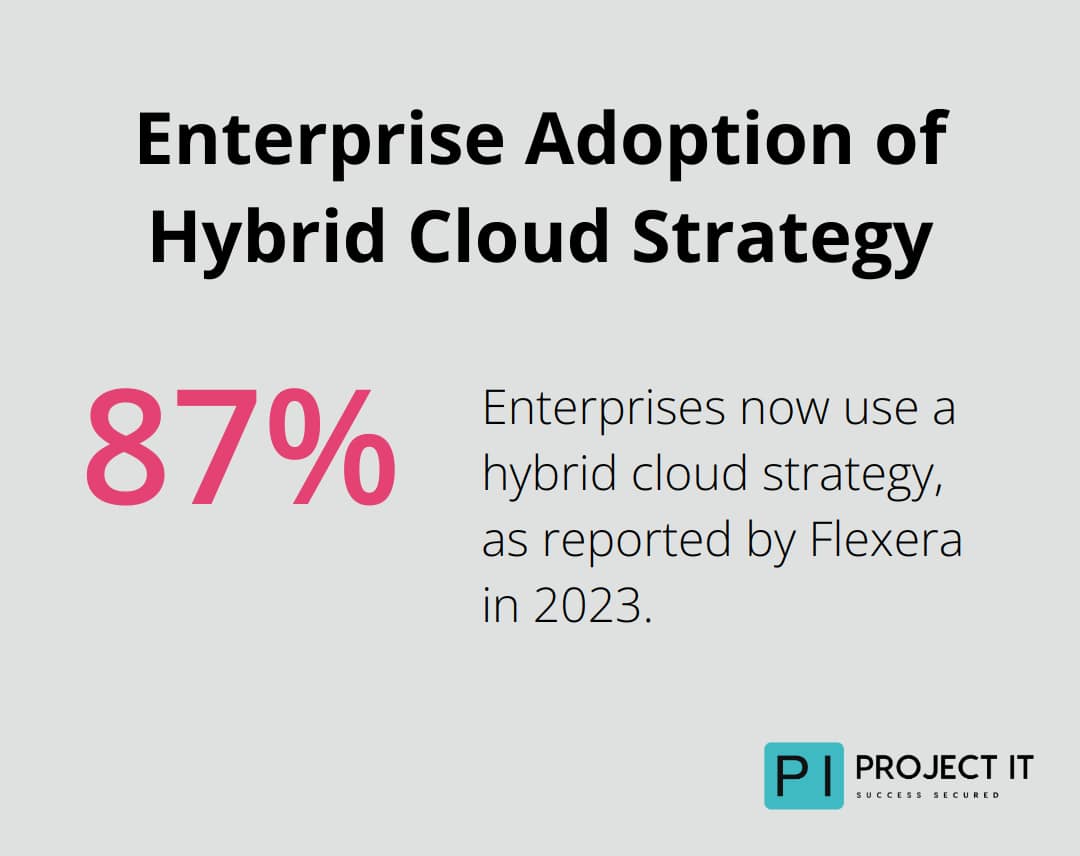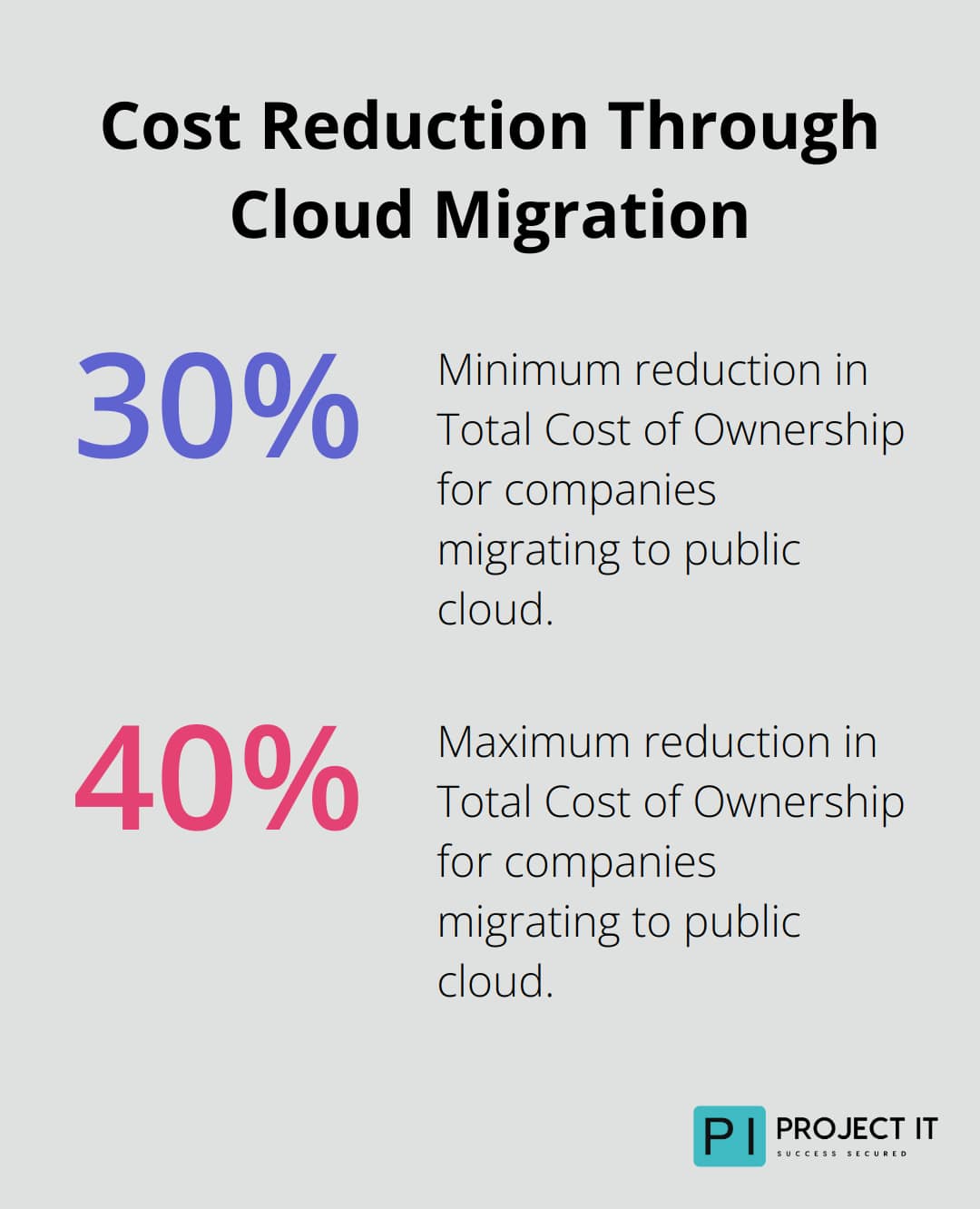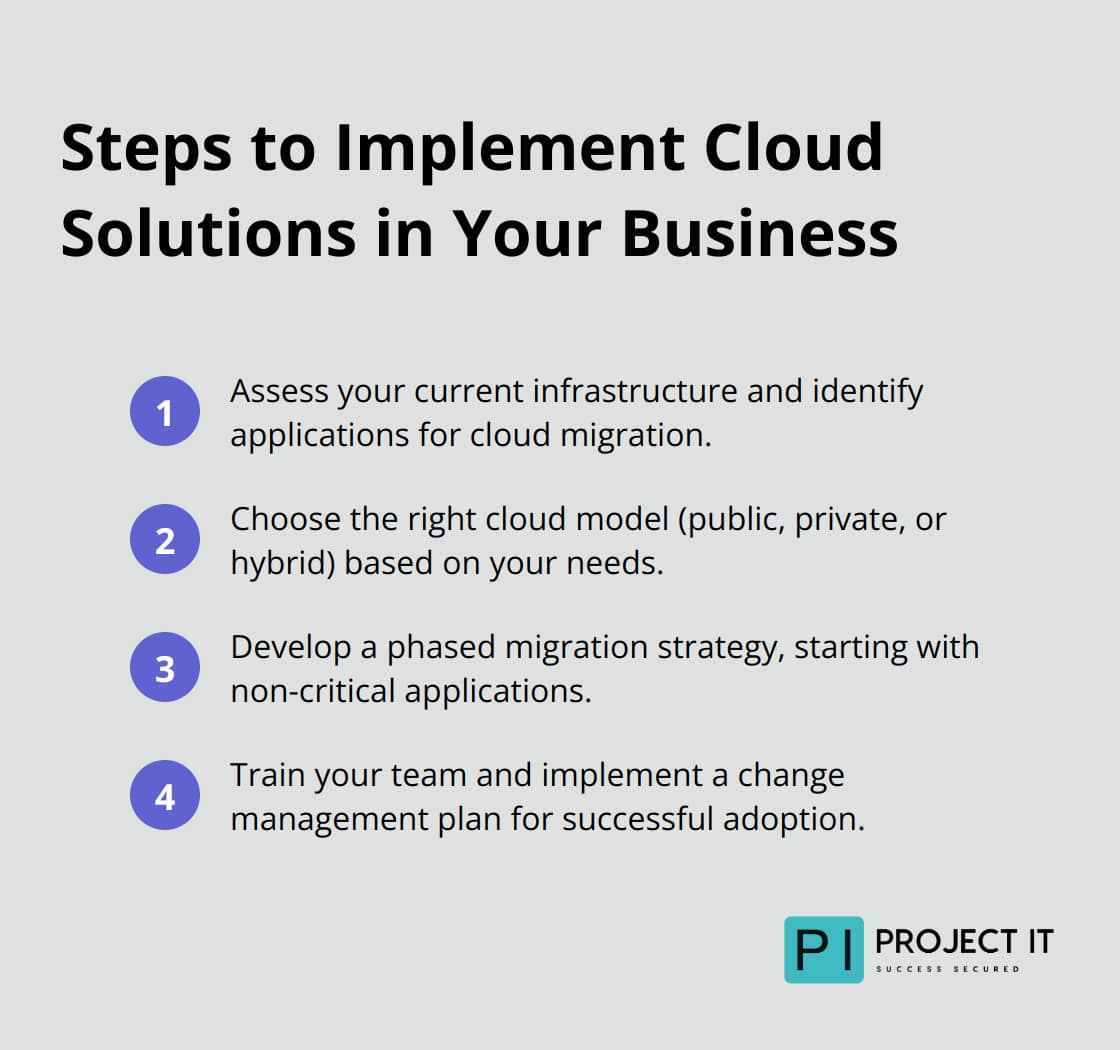Cloud computing has revolutionised the way businesses operate in the digital age. At Project IT, we’ve seen firsthand how this technology can transform organisations, boosting efficiency and driving growth.
In this post, we’ll explore the power of cloud computing and its impact on business operations. We’ll also provide practical steps for implementing cloud solutions in your company, helping you stay competitive in today’s fast-paced market.
What is Cloud Computing?
Cloud computing transforms how businesses operate in the digital age. This technology provides on-demand access to computing resources over the internet, offering much more than just remote data storage.
Types of Cloud Computing
Cloud computing comes in three main types: public, private, and hybrid.
Public clouds (like Amazon Web Services or Microsoft Azure) offer services to multiple clients using shared infrastructure. These platforms provide scalability and cost-effectiveness.
Private clouds dedicate resources to a single organisation. While more expensive, they offer greater control and security.
Hybrid clouds combine both public and private elements. This approach allows businesses to balance security needs with scalability. A 2023 Flexera report reveals that 87% of enterprises now use a hybrid cloud strategy, highlighting the growing recognition of this flexible approach.

Key Components of Cloud Infrastructure
Cloud infrastructure consists of several essential elements:
- Data centres: Physical locations housing servers
- Networking: Hardware and software enabling data transfer
- Storage: Various options from basic file storage to advanced database services
- Virtualisation: Technology allowing multiple virtual servers to run on a single physical machine
The Evolution of Cloud Technology
Cloud computing has advanced significantly since its inception. Amazon’s launch of AWS in the early 2000s marked the beginning of modern cloud services. Since then, the field has seen rapid progress.
Edge computing represents a significant trend. This approach processes data closer to its source, reducing latency. IDC predicts that spending on edge computing is expected to reach near $378 billion by 2028, growing at a solid double-digit CAGR.
Serverless computing also marks an important development. This model enables developers to build and run applications without managing servers, further simplifying IT operations.
AI and Machine Learning Integration
Artificial Intelligence (AI) and machine learning now integrate increasingly with cloud services. This combination opens new possibilities for data analysis and automation, further enhancing business efficiency.
As businesses navigate these evolving cloud technologies, they discover new ways to improve efficiency and drive innovation. The next section will explore the specific benefits cloud computing brings to business efficiency, showing how this technology can transform operations and boost productivity.
How Cloud Computing Boosts Business Efficiency
Cloud computing revolutionises business operations, offering unparalleled advantages in efficiency and productivity. Let’s explore the key ways cloud adoption transforms companies across industries.
Cost Reduction and Instant Scalability
Cloud computing slashes IT costs significantly. Companies migrating to the public cloud experience a 30-40% reduction in Total Cost of Ownership (TCO), emphasising the critical role cloud optimisation plays in reducing costs. AI and cybersecurity also drive cost reduction in IT.

Scalability is another game-changer. Cloud services allow businesses to scale resources up or down instantly based on demand. This flexibility proves particularly valuable for companies with fluctuating workloads or seasonal peaks. For instance, an e-commerce platform can easily handle a surge in traffic during holiday sales without investing in permanent infrastructure.
Enhanced Collaboration and Accessibility
Cloud-based tools dramatically improve team collaboration. A survey by Salesforce found that 94% of businesses reported significant improvements in security and 65% in workplace efficiency after adopting cloud technology.
These platforms enable real-time document editing, seamless file sharing, and instant communication, regardless of team members’ locations. This proves especially important in today’s increasingly remote work environment. Cloud solutions break down geographical barriers, allowing businesses to tap into global talent pools and operate 24/7.
Improved Data Security and Disaster Recovery
Contrary to common misconceptions, cloud computing often provides superior data security compared to on-premises solutions. Cloud providers invest heavily in state-of-the-art security measures that most individual businesses cannot match.
Moreover, cloud-based disaster recovery solutions offer unparalleled protection against data loss. According to IDC, companies using cloud services for backup and recovery resolve issues in an average of 2.1 hours, compared to 8 hours for those not using cloud services.
Faster Deployment and Time-to-Market
Cloud computing accelerates the deployment of new applications and services. This speed allows businesses to respond quickly to market changes and customer demands. A study by IDC found that cloud adopters bring new capabilities to market 20.66% faster than organisations not using cloud technology.
The ability to provision resources instantly (often with just a few clicks) eliminates the long wait times associated with traditional IT infrastructure setup. This agility gives businesses a significant competitive advantage in fast-moving markets.
Improved Analytics and Decision-Making
Cloud platforms offer powerful analytics tools that help businesses make data-driven decisions. For example, real-time analytics can enable personalised promotions or adjust pricing dynamically based on demand, improving sales and customer satisfaction.
As we’ve seen, cloud computing offers numerous benefits that can significantly boost business efficiency. The next step is to understand how to implement these powerful solutions effectively in your organisation. Let’s explore the practical steps you can take to leverage cloud computing in your business.
How to Implement Cloud Solutions in Your Business
Cloud solutions can transform your business operations, but they require careful planning and execution. This guide will help you navigate the process effectively.

Assess Your Current Infrastructure
Start with a thorough evaluation of your existing IT infrastructure. Identify which applications and data you want to move to the cloud. Many enterprises use a hybrid cloud strategy, combining on-premises and cloud solutions. This approach often provides the best balance of control and flexibility.
Analyse your current costs, including hardware, software licences, maintenance, and staff time. This baseline will help you measure the ROI of your cloud migration. Many businesses underestimate their current IT costs, which leads to unrealistic expectations about cloud savings.
Choose the Right Cloud Model
Selecting the appropriate cloud model is important. Public clouds (like AWS or Azure) offer scalability and cost-effectiveness but may have limitations for highly regulated industries. Private clouds provide more control but require greater investment. Hybrid clouds offer a mix of both.
Consider your specific needs. Do you need rapid scalability for seasonal demand? Are you dealing with sensitive data that requires strict compliance? Your answers will guide your choice. A healthcare provider might opt for a private cloud to ensure HIPAA compliance, while an e-commerce business might choose a public cloud for its scalability during peak shopping seasons.
Develop a Phased Migration Strategy
Don’t migrate everything at once. A phased approach reduces risk and allows for learning and adjustment. Start with non-critical applications to test the waters. This strategy aligns with best practices observed in successful migrations.
Prioritise applications based on their importance and complexity. Cloud-native apps are typically easier to migrate than legacy systems. For complex migrations, consider engaging a specialist to ensure a smooth transition.
Train Your Team and Manage Change
Cloud adoption isn’t just a technical change; it’s a cultural shift. Invest in comprehensive training for your staff. Organisations that prioritise cloud skills training are more likely to successfully implement cloud strategies.
Create a change management plan to address resistance and ensure buy-in across your organisation. Clear communication about the benefits and impact of cloud adoption is key. Successful cloud implementation relies as much on people as it does on technology.
Final Thoughts
Cloud computing revolutionises business operations, offering unparalleled benefits in efficiency, scalability, and cost-effectiveness. Companies can reduce IT expenses, enhance collaboration, improve data security, and accelerate time-to-market for new products and services. The future of cloud technology promises exciting developments, including edge computing, serverless architectures, and AI integration, which will further amplify business efficiency.
We at Project IT understand the complexities of cloud migration and the importance of tailored solutions. Our team of experts can guide you through every step of your cloud computing journey, from initial assessment to implementation and ongoing management. We provide comprehensive IT solutions designed to empower your business with secure, efficient, and innovative technology.
Cloud computing represents a strategic move that can propel your business forward. It positions your organisation to thrive in an increasingly digital world, ready to adapt to new challenges and seize emerging opportunities. Embrace cloud solutions today and unlock your business’s full potential in the digital age.


